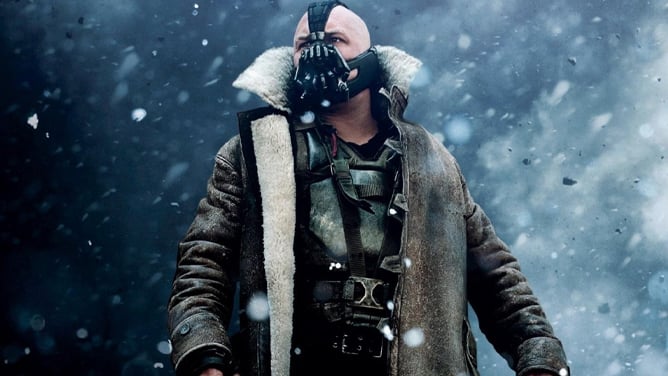Pulp Fiction. The Dark Knight. Schindler’s List. Each of these films enjoy a spot in film’s pantheon, and qualify as modern classics. This will inevitably make more than a few folks who grew up in these movies’ eras wither on the spot. For them, “classic” refers to films made before their time: The oldies but goodies from the 1970s, ’60s, and ’50s. “Old” and “classic” being relative terms, and Netflix being a revolving door for any movie the streaming service can’t claim as an “original,” a line can be drawn that divides everything made after 1990 or so from everything made before.
Let’s not downplay the reality here: Netflix’s library is sorely lacking in classics, whether American or international. But the library is so vast that, if only by accident, a handful of bona fide masterworks made in decades long past remains available for your viewing pleasure. Just make sure you watch them all before Netflix makes like an Etch A Sketch and shakes these films out of their lineup.
White Christmas (1954)
Every year, people argue about whether or not Die Hard is the greatest Christmas movie of all time, or wax nostalgic about the time they shot themself with a BB gun after watching A Christmas Story for the millionth time. Nothing compares to White Christmas, though. It’s absurdly saccharine. It’s unabashedly cheerful. It’s a sappy, romantic musical. It’s the film version of a Starbucks peppermint mocha, and yet it remains a holiday classic because of the execution, the star power, and, yes, the sentiment. It probably also has something to do with the fact that it features Bing Crosby singing the Irving Berlin hit “White Christmas,” which, according to Guinness, is still the best-selling single worldwide more than 60 years later.
Cairo Station (1958)
Youssef Chahine’s neorealist-noir bromide holds the distinction of being the first Arabic film submitted for consideration in the Academy Awards’ Best Foreign Language Film category. The Academy accepted it as the Egyptian entry for 1959, but it didn’t make it through the nomination process. So it goes, but it’s still a great movie, and that’s all that matters. Chahine documents Egyptian life after the 1952 fall of the Egyptian monarchy, with a focus on working class struggles and the relationship between sexual repression and sexual violence. He packs a great deal of thought into an hour and 10 minutes of running time, and makes every beat count. An economic, excellent movie.
Saladin (1963)
If it’s not already clear based on Cairo Station’s presence on this list, Youssef Chahine is a pretty big deal in 1950s and 1960s world cinema. Saladin shouldn’t be called “revelatory,” because Saladin came well before better-known movies about the Crusades, like Robin Hood (take your pick), Kingdom of Heaven, and Lionheart. At the same time, the film had the misfortune of being sandwiched between those movies and movies like Ivanhoe and King Richard and the Crusaders. Here, we see a pattern of the movies showing audiences these medieval religious wars from an Arabic perspective instead of just a European POV. Whatever you think of the film itself, and the film is very good, the shift in vantage makes a big difference.
Play Misty for Me (1971)
Picturing Clint Eastwood any way other than grizzled takes work. His no-nonsense tough guy image is the mold he’s cast himself for broad swaths of his career, even in movies that don’t call for him to sling guns at bad guys, a’la Gran Torino. The toughness is there; Eastwood, directing for the first time, just keeps it in his gut until the film’s climax, where he unleashes on Jessica Walter after 90 minutes of suffering her character’s obsessive, possessive violence. Play Misty for Me is not only one of the greatest films of the 1970s (arguably the greatest decade of American cinema) but a sharp contrast to Eastwood’s long-accepted macho persona, no matter that the persona is informed by stereotyping.
The Sting (1973)
George Roy Hill’s conman caper film is a rarity: Bulletproof popcorn. In 1973, The Sting’s less glowing reviews, hung up on trifling details like plot complications and surface-level theatricality, still conceded the film’s entertainment value wrung from the irresistible charms of leading men Robert Redford and Paul Newman. Granted, favorable notices outnumbered the unfavorable ones: The Sting raked in thumbs ups alongside heaps of cash, not to mention seven wins out of 10 nominations at the 46th Academy Awards. But a movie whose critics find fault while still enjoying themselves is a special thing, and The Sting, now a ripe 50 years old, is undeniably special.
Monty Python and the Holy Grail (1975)
There’s a scientific trial worth conducting to prove which Monty Python movie has the most staying power among all Monty Python movies, quantified through quotability. As no one’s dedicated themself to this important undertaking, I’ll just have to take my best guess on Monty Python and the Holy Grail. The movie’s title alone will, for many viewers, spark a free association recitation of various one-liners responsible for keeping the picture alive in popular consciousness almost a half century after its release: Your father was a hamster, strange women lying in ponds distributing swords is no basis for a system of government, it’s just a flesh wound. The Holy Grail is an all-timer.
Rocky (1976)
If proof is needed of Rocky’s legacy as one of the enduring franchises in American cinema, then remember that Creed III, the next entry in the Creed series that spun off of the then-39-year-old Rocky franchise in 2015, releases in 2023. Yes, the Creed movies are only about Rocky Balboa adjacent to Adonis Creed; no, this does not disqualify them as Rocky movies. They use the same language. They adopt the same structure and tropes. They aren’t the product of scrappy independent grit on account of their studio-sized budgets, but let’s not hold that against them. Movies like Rocky tend to happen when the absence of funds forces creativity, which makes the film’s place in pop culture all the more astounding. It’s an underdog movie and an underdog itself at the same time.
Grease (1978)
Grease is a movie about nostalgia for the 1950s. Pining for Grease, of course, makes perfect sense. If The Sting is popcorn, Grease is cotton candy laced with Skittles–a massive sugar rush that lasts well beyond its two hour running time. The soundtrack is key to the experience. Grease wouldn’t be the same without John Travolta and Olivia Newton-John, sure, but it’s the songs, from “Grease Lightnin’” to “Hopelessly Devoted to You” to “You’re the One That I Want,” that pulls viewers into the film’s reenactment of an idealized America that never existed.
Monty Python’s Life of Brian (1979)
What’s that, now? Two Monty Python movies on the same list? Foul, you may cry, but let Monty Python’s Life of Brian’s inclusion here be proof of two things: First, that Netflix is a desert of classic cinema, where recency bias reigns; and second, that Life of Brian is an all-timer. Like The Holy Grail, Life of Brian is the Python crew’s take on period storytelling, where matters of historical significance are fodder for dry British smartassery. Unlike The Holy Grail, Life of Brian sparked a culture war led by rabbis, nuns, and traditionalist Christian bores who picketed screenings and littered the land with pamphlets that ultimately drummed up more attention for the film than anything else. (Nobody burned down a theater playing it, though, which is more than can be said of Martin Scorsese’s The Last Temptation of Christ.)
Apocalypse Now Redux (1979)
Napalm in the morning, ego and ambition on the screen. Apocalypse Now, Redux or not, remains the Hollywood object lesson of big budget auteurist filmmaking escaping from the filmmaker’s control. For the audience, only the result matters. There’s nothing quite like Francis Ford Coppola’s monumental war picture, with or without that extra 49 minutes of appended footage. For the people who made the movie, production was a unique hell on Earth, a shoot totaling nearly one year in length stymied by the elements, by funding, by Martin Sheen’s heart attack, and by, yes, grave robbing. It’s quite a story to read about, quite a movie to watch, and quite a memory most anyone involved in putting the whole thing together would rather not revisit.
The Four Seasons (1981)
Alan Alda’s comedy of manners could have easily been titled Alda: The Movie; he wrote, directed, and starred in it, and his daughters, Elizabeth and Beatrice, appear playing his character’s own daughters. It’s an Alda echo chamber. Not that this is a problem, per se. That’s a lot of Alda’s, but the Alda name is a good one, and his co-leads — Carol Burnett and Rita Moreno in particular — have big enough personalities to command the camera and keep The Four Seasons from being about him and him alone.
Labyrinth (1986)
Millennials may recall the nightmares Jim Henson’s final film gave them through the late ’80s and mid-’90s. That staying power led to a reevaluation through the 2000s to the early 2010s, when outlets like the Chicago Tribune and Empire declared it “good.” You’re more likely to remember the Fire Gang or the poisoned peach than, say, Sir Didymus or the film’s joyful parting image, but that’s a good thing. Labyrinth is a trip through the sunny side of Henson’s brain as well as its most macabre corners, where everything is familiar and foreign at the same time. There’s no doubting the film as the fruit of his imagination, but his imagination is never as eerie and twisted as it is here.
Top Gun (1986)
If a game show host challenged their contests to summarize Top Gun in three words, the winning phrase would be “U.S.A! U.S.A.! U.S.A.!” Top Gun is not a subtle movie. It isn’t a “smart” movie, either, in the sense that it is pro-thoughtlessness, as captured by Tom Cruise in one of countless quotable lines woven into Jim Cash and Jack Epps Jr.’s script: “You don’t have time to think up there. If you think, you’re dead.” But it’s “clever” in the sense that its breathtaking meat-headedness is held in check by its self-awareness, because what else can a movie starring Tom Cruise of all people be other than self-aware? Top Gun isn’t a movie you turn to for achieving meaningful existential catharsis. It’s a movie you turn to when you need to see airplanes zoom fast while the camera cuts faster, and when the only feature that matters to you is “cool.”
She’s Gotta Have It (1986)
Spike Lee made his undisputed masterpiece, Do the Right Thing, three years after She’s Gotta Have It, which unsurprisingly also counts as one of his masterpieces. Lee, if you didn’t already know, is very good at making movies. But She’s Gotta Have It is his first feature, and for a first feature shot for relative pennies it’s remarkably polished. Frankly, that would still be true if She’s Gotta Have It was a second or even a fourth feature. The movie demonstrates Lee’s facility for empathy and insight, and contextualized in the ’80s stands out as a landmark in Black American cinema and independent cinema writ large: Lee wrote characters who cut a stark contrast to the movies’ typical depictions of Black men and women as lower class and crooked, and instead showed American audiences a group of erudite Black urbanites. That’s as revolutionary an act as throwing a garbage can through a pizzeria window.
The Other Side of the Wind (1985, but Also 2018)
Netflix generously dropped about $6 million on completing Orson Welles’ final movie, shot over the course of several years in the early 1970s, technically finished in 1985, the year Welles passed, and then actually finished in 2018 after about a half decade’s worth of sweat equity put into that daunting task. The content and conceit of the film reflects the restorative effort. The Other Side of the Wind unfolds against the backdrop of macho Golden Age filmmaker Jake Hannaford’s (John Huston) 70th birthday, where a series of unfortunate events ultimately leads him to his end. Welles’ big idea is that Hannaford’s partygoers are packing 16 mm and Super 8 cameras, and that the movie comprises the footage they collectively captured. Remember when Welles invented the mockumentary in Citizen Kane? The man invented the found footage picture, too, and we didn’t know as much until years after The Blair Witch Project. Orson Welles, what a concept.




